For today’s dehydrator project, we are going to dehydrate sweet potatoes. We’re running low and need to make more to stock up our dehydrated food pantry.
We’re going to use frozen sweet potatoes. The hard work of peeling, cubing, and preparing the sweet potatoes has already been done for us.
In this step-by-step guide, we’ll review the tools and process of dehydrating sweet potatoes. We’ll also share some excerpts from my dehydrator logbook, where I record notes describing what I am dehydrating, the setup, duration, and before and after weights. This information informs future dehydrating projects.
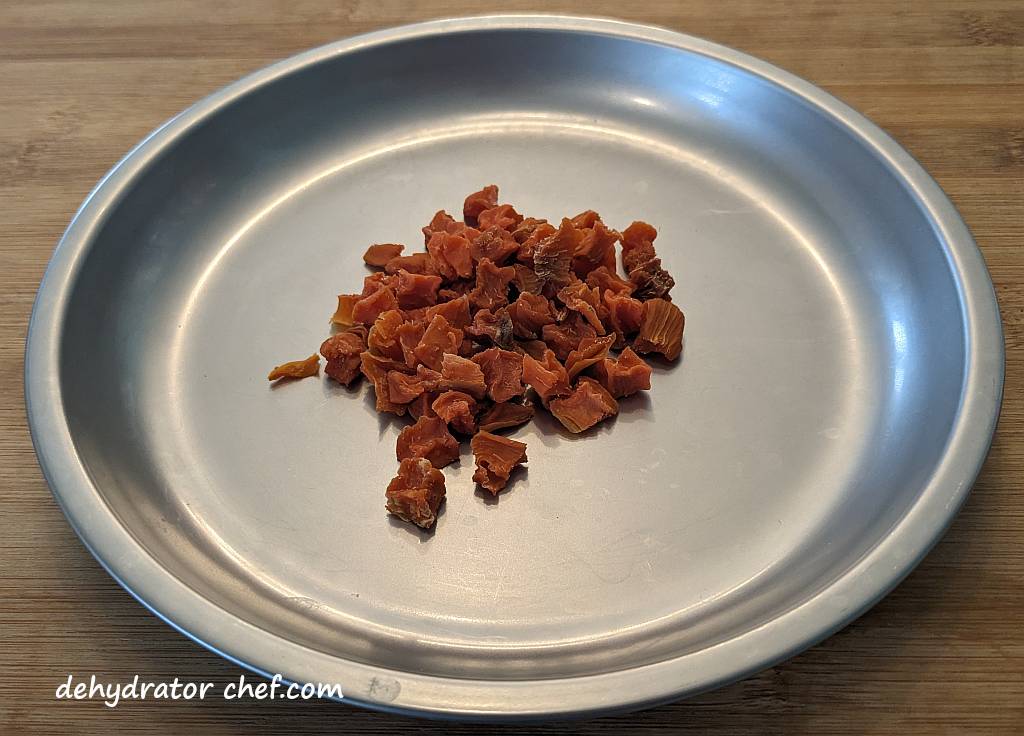
Lastly, we’ll wrap it up with a few insider tips and tricks worth mentioning. The primary focus of the Dehydrator Chef website is to create decent-quality, good-tasting foods that quickly and easily rehydrate using ordinary camping and backpacking kitchen gear.
So grab your dehydrator, and let’s get started dehydrating sweet potatoes.
Table of Contents
- How to Dehydrate Sweet Potatoes
- Supplies Needed to Dehydrate Sweet Potatoes
- Step 1. The Process to Dehydrate Sweet Potatoes
- Step 2. Preparing the Dehydrator for Dehydrating Sweet Potatoes
- Step 3. Dehydrating Sweet Potatoes
- Step 4. When are the Dehydrated Sweet Potatoes Done
- Step 5. Equalizing and Conditioning Dehydrated Sweet Potatoes
- Step 6. Storing Dehydrated Sweet Potatoes
- How to Rehydrate Sweet Potatoes
- Weights, Measures, and Serving Sizes
- Dehydrated Sweet Potatoes Nutrition Information
- Insider Tips
How to Dehydrate Sweet Potatoes
All you need to dehydrate these foods is a good quality food dehydrator. We use the Nesco food dehydrators. You can check out our food dehydrator guide to learn why we think Nesco offers the best bang for the buck. We believe this is the best food dehydrator for our long-term food storage needs.
A significant benefit of dehydrating already processed food is that the hard work of slicing, dicing, and processing the product has already been done for you. There is no shame in wanting to save some time.
One advantage of working with frozen sweet potatoes is that there’s no need to defrost them beforehand. However, it might be wise to allow them to thaw slightly so any larger clumps can more easily be broken apart.
Supplies Needed to Dehydrate Sweet Potatoes
To dehydrate sweet potatoes, you will need a good-quality food dehydrator. We use Nesco food dehydrators. Check out our food dehydrator guide to learn why Nesco offers the best bang for the buck.
To dehydrate frozen sweet potatoes, you’ll need the following supplies:
- A couple of bags of frozen sweet potatoes
- Food dehydrator
- Removable fruit roll sheet inserts, one for each dehydrator tray
- Standard kitchen tools, including cutting boards, chef’s knife, spatula, steamer, colander, etc.
- Clear canning jars with tight-fitting lids
- Wide-mouth canning jar funnel.
- Desiccant packets for moisture control (optional)
For planning purposes, a 10-ounce bag of frozen sweet potatoes will fill one Nesco 13.5-inch round dehydrator tray. Since we mostly dehydrate individual ingredients for our meals, we’ll dehydrate several bags at once to replenish our pantry and make the most of our time.
You’ll also need removable fruit roll sheet inserts, one for each dehydrator tray.
Step 1. The Process to Dehydrate Sweet Potatoes
There isn’t much to do in the way of preparing the frozen sweet potatoes for dehydration. However, the preparation instructions on the product bag say they need to be cooked before consumption.
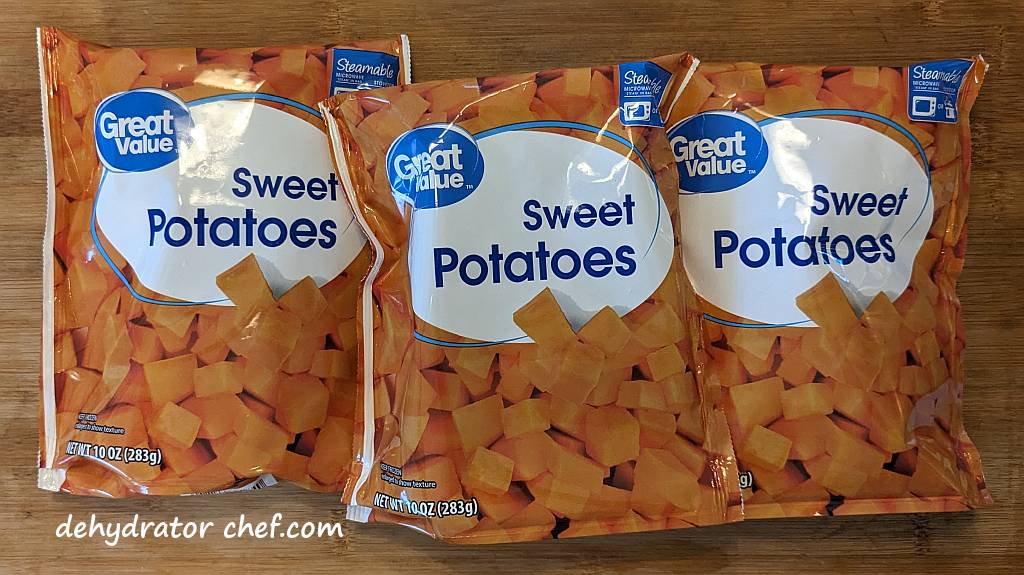
We will steam-cook the frozen sweet potatoes for a few minutes. We’ll steam them for 8 minutes, the same amount of time as shown in the stovetop instructions.
We’ll use a steamer basket and steam them in batches. After steaming, we’ll let them cool a bit. We’ll also do a taste test after a minute or so of steaming to gauge tenderness. We want some tenderness and also some bite left.
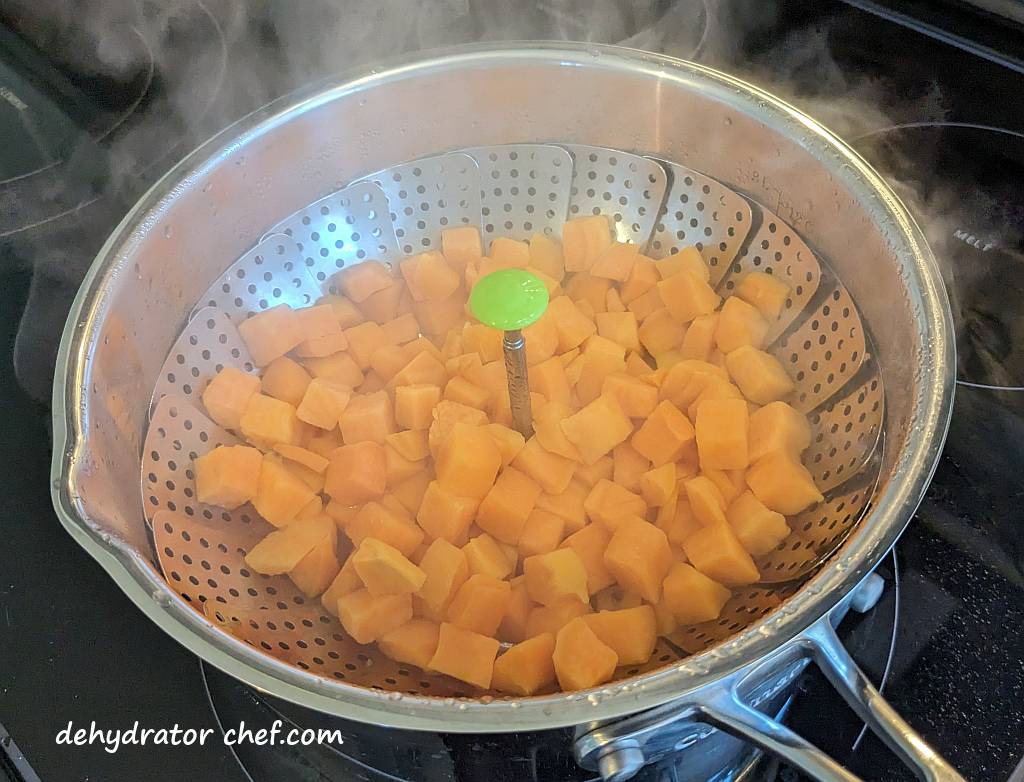
To begin, open the bag and place a couple of handfuls of the frozen sweet potatoes in the steamer basket, breaking apart any large clumps. After 8 minutes, remove the steamer basket from the boiling water. Avoid steaming them for too long, as they may turn mushy.
Set the batch of steamed sweet potatoes aside to cool until you have finished steaming all of the sweet potatoes.
Step 2. Preparing the Dehydrator for Dehydrating Sweet Potatoes
One 10-ounce bag of frozen sweet potatoes will fill one round Nesco 13.5-inch dehydrator tray with the removable fruit roll sheet insert.
To ensure even drying, spread the cooled sweet potatoes in a single layer onto the removable fruit roll sheet inserts.
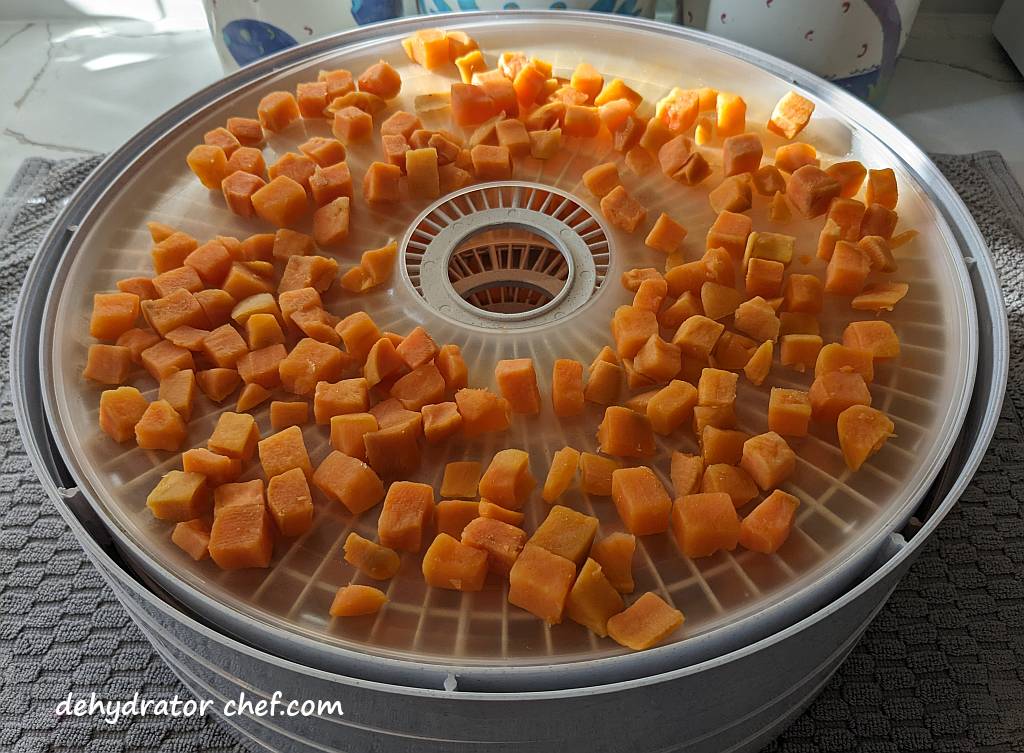
Remove anything that looks questionable as you spread the cooled sweet potato cubes onto the dryer trays. These sweet potatoes are mechanically processed. Despite the use of modern processing equipment, it is not always possible to remove all foreign materials, bits of stem, and off-colored pieces of sweet potato.
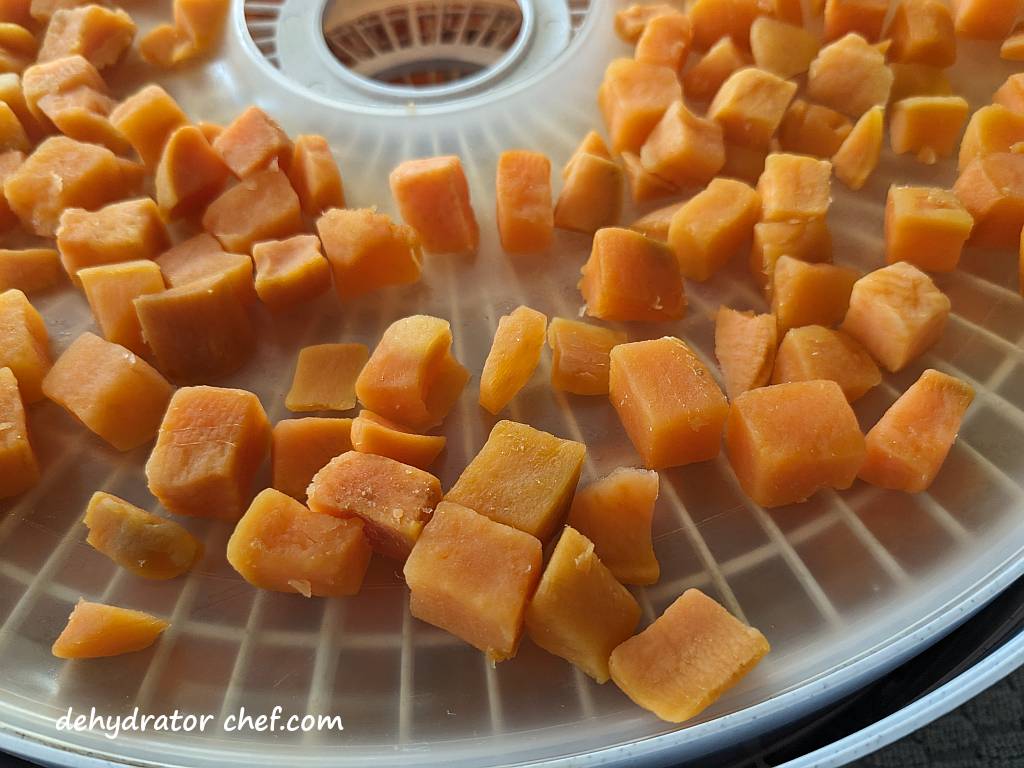
The Nesco 13.5-inch round dehydrator tray has close to 119 square inches or .8 square feet of surface area for drying.
We will use these removable Nesco fruit roll sheet inserts on our food dehydrator for today’s project. They have over 3000 customer reviews with an average rating of 4.5 stars out of 5, which is evidence of a great product. Check out other Nesco food dehydrator products here.
Step 3. Dehydrating Sweet Potatoes
Begin by setting the dehydrator thermostat to 135°F (57°C). Based on my experience, a drying time of 18 to 24 hours works well for dehydrating sweet potatoes.
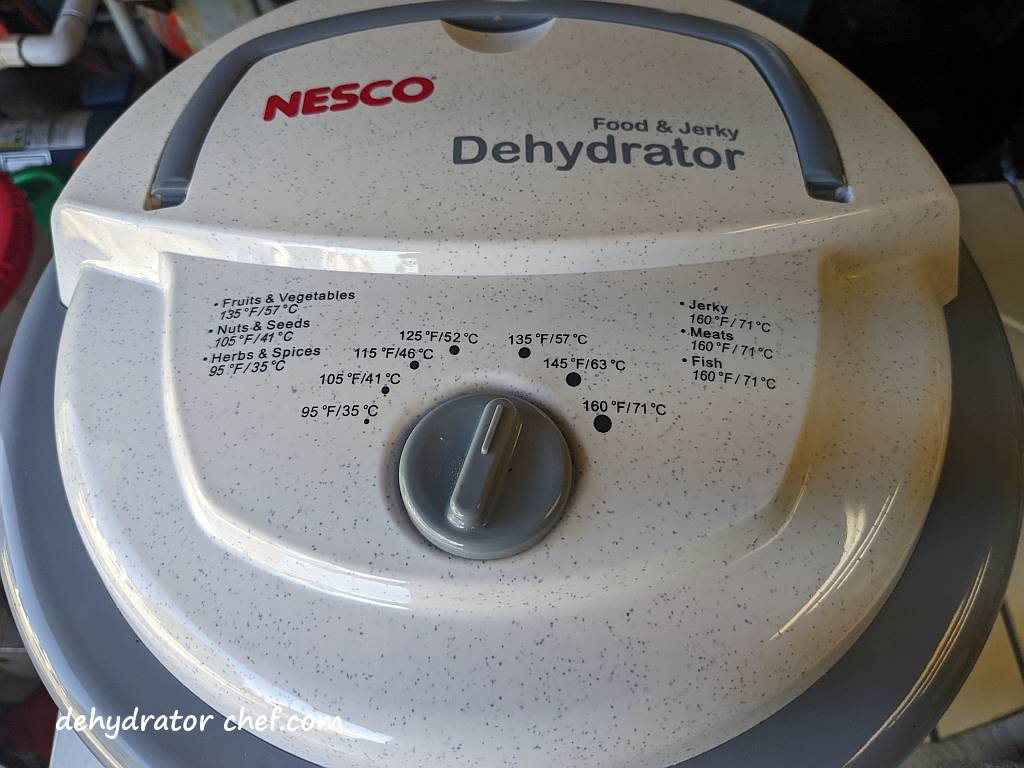
Remember to use drying times only as a guide. Of course, drying times are variable and dependent on your food dehydrator, the ambient temperature and humidity, the number of trays, and how crowded or thickly you layer food into your dehydrator trays.
Step 4. When are the Dehydrated Sweet Potatoes Done
After 18 to 24 hours, the sweet potato cubes should be fully dehydrated. If not, let it go another 2 or 4 hours and check again.

The dehydrated sweet potato cubes are done when they are hard little cubes. They should not be mushy or pliable.
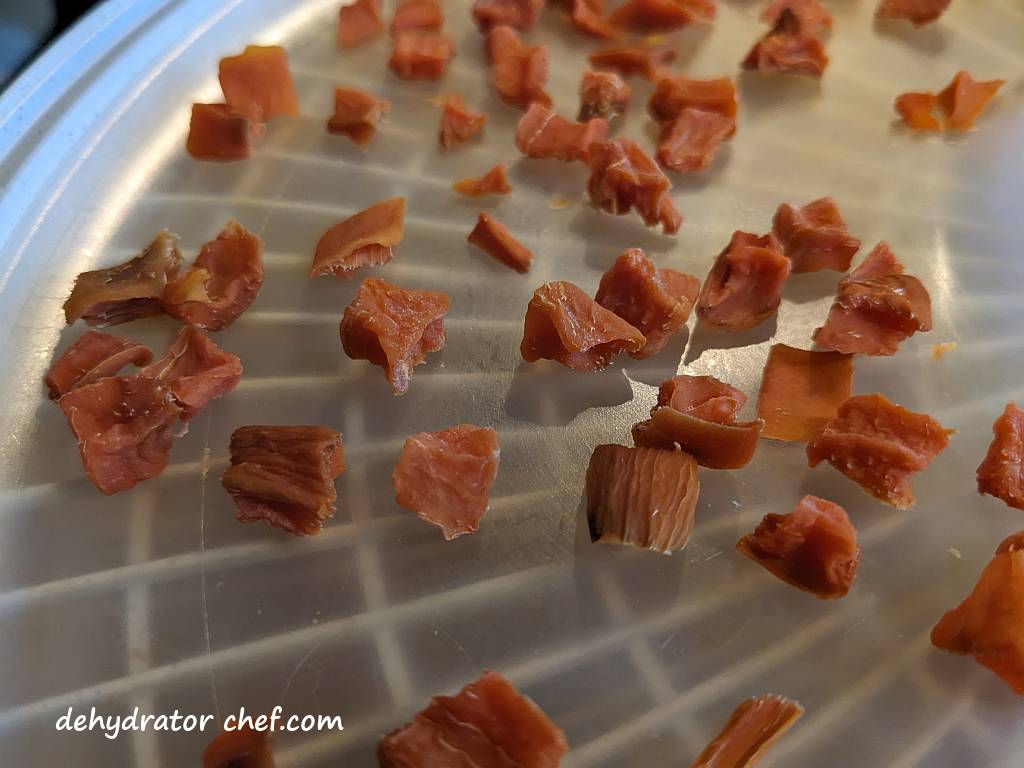
Drying times will vary depending on your dehydrator. Refer to your dehydrator owner’s manual for recommended temperatures and times for dehydrating specific foods. Remember to use drying times as a guide.
Step 5. Equalizing and Conditioning Dehydrated Sweet Potatoes
When the dehydrated food pieces are removed from the dehydrator, the remaining moisture may not be distributed equally among the pieces because of their location and position in the dehydrator. Equalizing and conditioning is a process for freshly dehydrated foods that ensures any residual moisture remaining in any piece is spread or equalized among all the other pieces in the batch. Let the dried sweet potatoes equalize and condition in the storage container for 7 to 10 days.
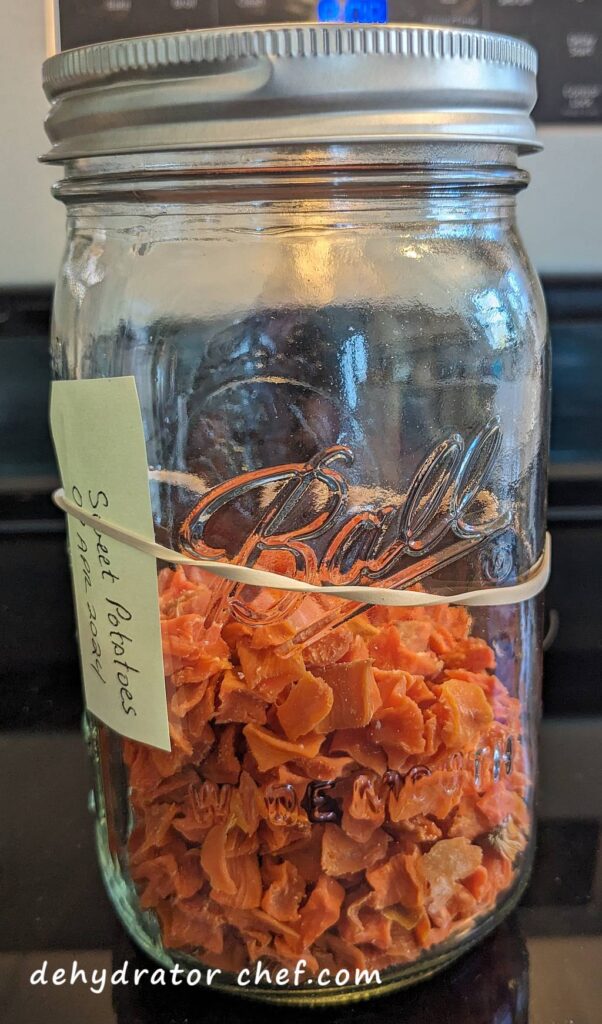
We always recommend letting food items cool completely after they have finished dehydrating and before packing them into an airtight storage container for equalizing and conditioning. Warm food may cause sweating, which could provide enough moisture for mold to grow.
It does not take long for dehydrated food items to start hydrating from ambient household humidity. Do not leave dehydrated food items exposed to the elements any longer than necessary because of the increased risk of mold growth.
After a brief cooling period, loosely pack the dehydrated sweet potato pieces into a clean, dry, insect-proof, and air-tight storage container.
We use the larger canning jars for equalizing and conditioning. Since they are clear, it’s easy to see what’s inside. Fill the jars at most 2/3 to 3/4 full, leaving some headspace.
Headspace is the distance between the food surface and the lid’s underside. Its purpose is to provide ample space for the dehydrated food product to slide and tumble when shaken and rotated to expose any evidence of clumping or sticking.
A quality stainless steel or plastic canning jar funnel makes the messy job of getting dehydrated foods off the dehydrator tray removable inserts and into the canning jars an easy task. Take a minute or two and check them out on Amazon.
Every day, check the jar for moisture. Roll the jar contents around and note any clumping or sticking. If seen, put the contents back on the dehydrator for several more hours. Since canning jars are clear, it’s easy to see what’s inside.
If you notice any mold, even the smallest bit, throw it all out. What you see are the mold spores finally blooming enough to make them visible. But there are more, even tinier mold spores in the rest of your jar that make your dehydrated food inedible. Toss it out and start another batch.
Step 6. Storing Dehydrated Sweet Potatoes
Use an appropriately sized canning jar for storage. The dehydrated sweet potatoes might keep up to 12 months or longer. Exactly how long depends on how well you dehydrate the sweet potatoes and your pantry storage conditions.
We’ll use a food-safe desiccant packet for moisture control because we live in a fairly humid area. For our pint-size or quart-size mason jars, we’ll use a single food-safe 5-gram desiccant packet. For larger jars, we’ll add 2 packets. The desiccant packets will absorb any moisture and help extend the shelf life of the dehydrated food.
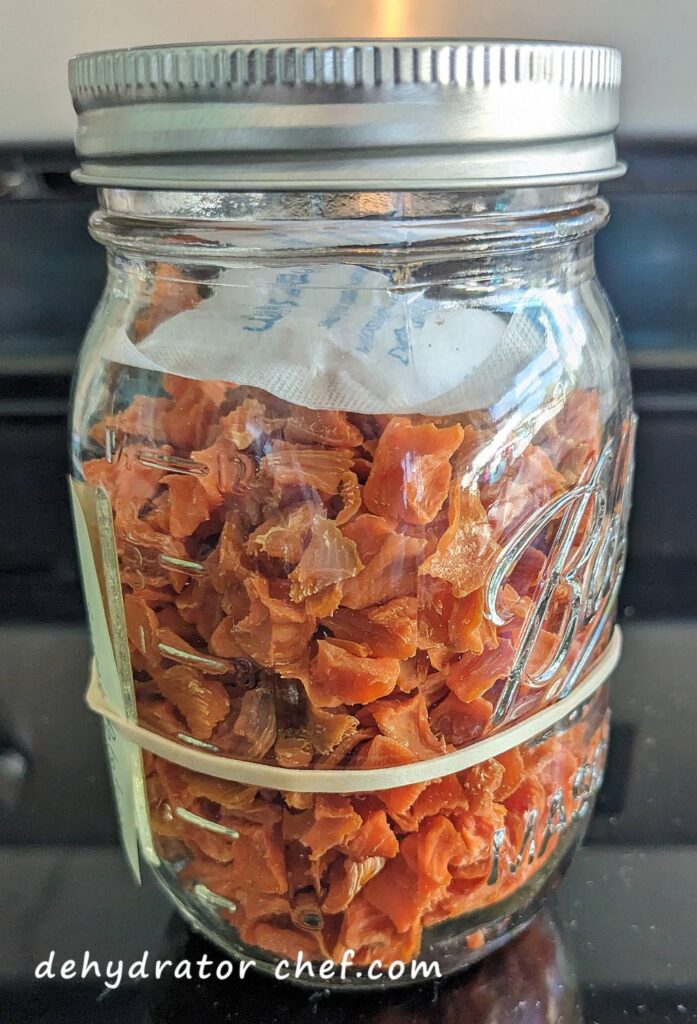
We use these inexpensive food-safe desiccant packets, which are available from Amazon. These 5-gram packets have over 5000 of mostly 4- and 5-star customer reviews, with an average of 4.7 stars out of 5. Our bag of 60 desiccant packets will last quite a while because they can be recharged and reused multiple times. Other food-safe sizes are available.
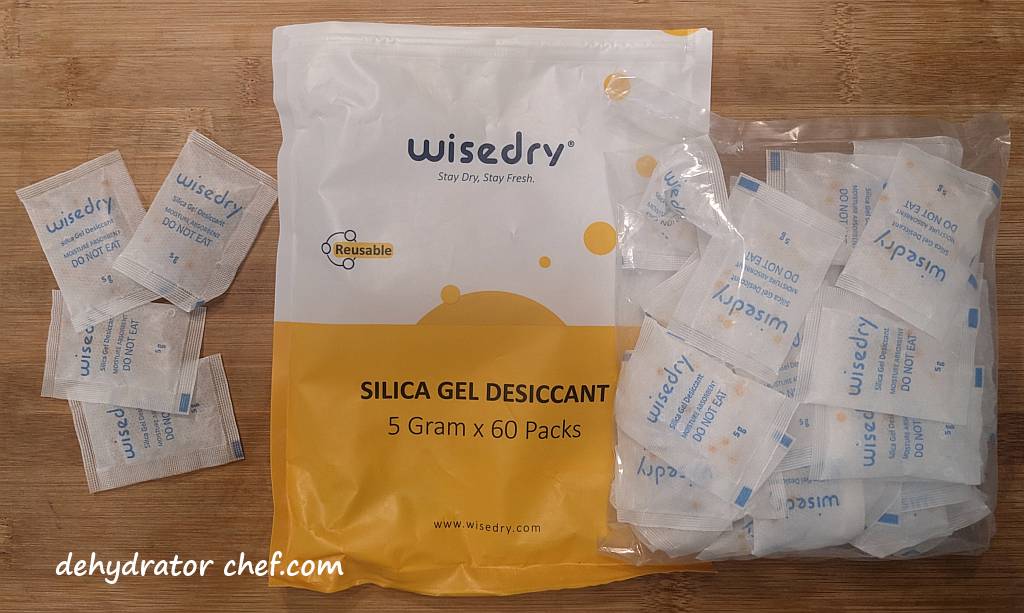
Lastly, attach or include a short note describing the contents and the date the product was dehydrated. The note also informs us where to go in the dehydrator logbook to make another note.
How to Rehydrate Sweet Potatoes
Hydrate the dried sweet potatoes using roughly a 1-to-1 ratio of dehydrated product to boiled water. Plan on at least 15 to 20 minutes to fully hydrate.
If you’re supplementing store-bought freeze-dried meals as we often do, just add a bit more boiling water to the food pouch. Use the same 1-to-1 ratio of dehydrated product to water and account for the extra time. Most store-bought freeze-dried meals could use a little extra to bump up the calorie count, or add more content or nutrition.
Weights, Measures, and Serving Sizes
This information is summarized from our logbook we keep on most of our food dehydration projects.
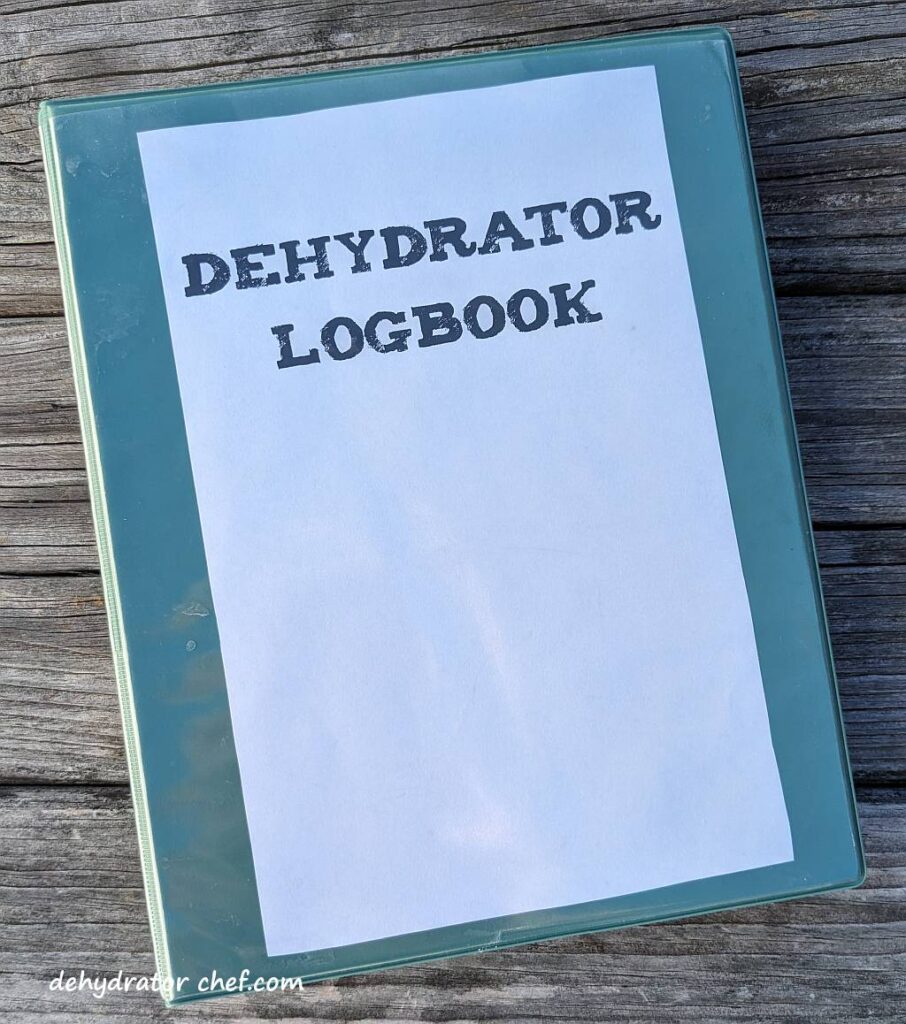
One 10-ounce bag of frozen diced sweet potatoes, about 2.5 servings, will dehydrate to approximately 55 grams. So each serving is about 22 grams.
Dehydrated Sweet Potatoes Nutrition Information
Serving Size: 22 grams | Calories: 90kcal | Total Fat: 0g | Saturated Fat: 0g | Cholesterol: 0mg | Sodium: 60mg | Carbohydrate: 22g | Dietary Fiber: 3g | Sugar: 5g | Protein: 2g
 | The Dehydrator Chef Book Available only on Amazon.com You’ll find step-by-step instructions for 26 homemade dehydrated camping meals. Many recipes are only available in this book. Grab yourself a copy today. |
Insider Tips
Besides dehydrated meal recipes found here on this website, add dehydrated sweet potatoes to any of your favorite freeze-dried food pouches for a bit more nutrition.
Just be sure to compensate by adding additional boiled water in roughly a 1-to-1 ratio of product to boiling water to the freeze-dried meal and allow enough time for adequate hydration.

How to Dehydrate Sweet Potatoes
Equipment
- Removable fruit roll sheet insert (one for each dehydrator tray)
- Common kitchen tools (including cutting boards, chef’s knife, spatula, steamer, colander, etc.)
- Canning jars with tight-fitting lids
- Desiccant packets for moisture control (optional)
Ingredients
- several packages frozen diced sweet potatoes
Instructions
Process the Frozen Sweet Potatoes
- Working in batches, steam the frozen sweet potatoes for approximately eight minutes until they are just tender.several packages frozen diced sweet potatoes
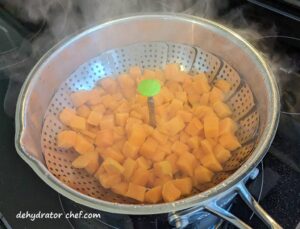
- Plunge the steamed sweet potatoes into an ice water bath to stop the cooking process. Then drain.
Prepare the Dehydrator
- Layer the sweet potato pieces onto the removable fruit roll sheet inserts; one 10-ounce package will fill one Nesco 13.5-inch round dehydrator tray.
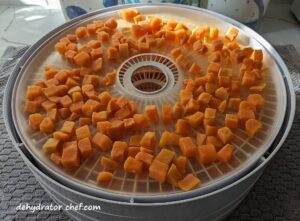
- Inspect the sweet potatoes as you layer them on the trays; remove anything that shouldn't be there.
Dehydrate the Diced Sweet Potatoes
- Set the dehydrator thermostat temperature to 135 °F (57 °C). Dry for 18 to 24 hours until done.
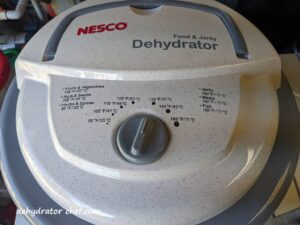
When are the Dehydrated Sweet Potatoes Done
- When done, the dehydrated sweet potato pieces should be hard, little square nuggets. There should be no wet or mushy pieces.

Equalizing and Conditioning Dehydrated Sweet Potatoes
- After a short cooling period, loosely pack the dehydrated sweet potato pieces into a clean, dry canning jar with a tight-fitting lid, leaving some headspace.
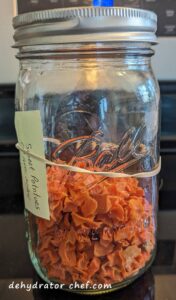
- Every day, for 7 to 10 days, check the jar for moisture. Roll the jar contents around and note any clumping or sticking. If seen, put it all back on the dehydrator for several more hours.
- If you notice any mold at all, even the slightest bit, throw it all out.
Storing the Dehydrated Potatoes
- Use appropriate-sized canning jars for storage. Depending on how well you dehydrate them and your pantry storage conditions, the dehydrated sweet potato pieces should keep for at least 12 months.
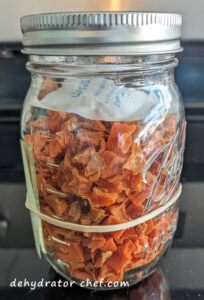
- An optional food-safe desiccant packet will aid with moisture control.

- Attach or include a label describing the jar contents and the date the product was dehydrated. The label identifies the canning jar contents, and the date helps with the rotation schedule. A first-in, first-out rotation helps us to use items that have been on the shelf the longest, so we're using the oldest food first.
Notes
Nutrition
Nutrition information is only an estimate and may differ depending on the ingredients you use.

2 replies on “How to Dehydrate Sweet Potatoes – Dehydrating Sweet Potatoes, A Step-by-Step Guide”
The blog recommends keeping them in jars for 7–10 days to check for clumping or moisture. Is that always necessary, or just in humid environments? Could I skip this if I’m in a dry climate?
Hi R.
Good question. The canning jars with airtight lids are environments of their very own. The contents are not routinely exposed to your dry climate. After the sweet potatoes have fully dehydrated, the equalizing and conditioning step gives any remaining moisture time to distribute and equalize among all of the other sweet potato pieces in the canning jar.
When you dehydrate a batch of food, not every piece loses moisture at the exact same rate. Some might be completely dry, while others may still have a little hidden moisture inside. By loosely packing them in the canning jar with a tight-fitting lid for 7–10 days and shaking it daily, any leftover moisture redistributes evenly.
Sure, after you have gained experience drying foods, and you’re confident you have sufficiently dehydrated it, you may feel okay about shortcutting this step by a few days. After several decades of drying food, I’ll still equalize and condition foods for several days prior to adding one or two food-safe desiccant packets for moisture control.
Bottom line, equalizing and conditioning is a best practice. As a beginner, I’d follow the 7–10 day equalizing step every time until I get more experience. It’s a simple insurance policy against mold ruining a whole batch. Hope this helps.